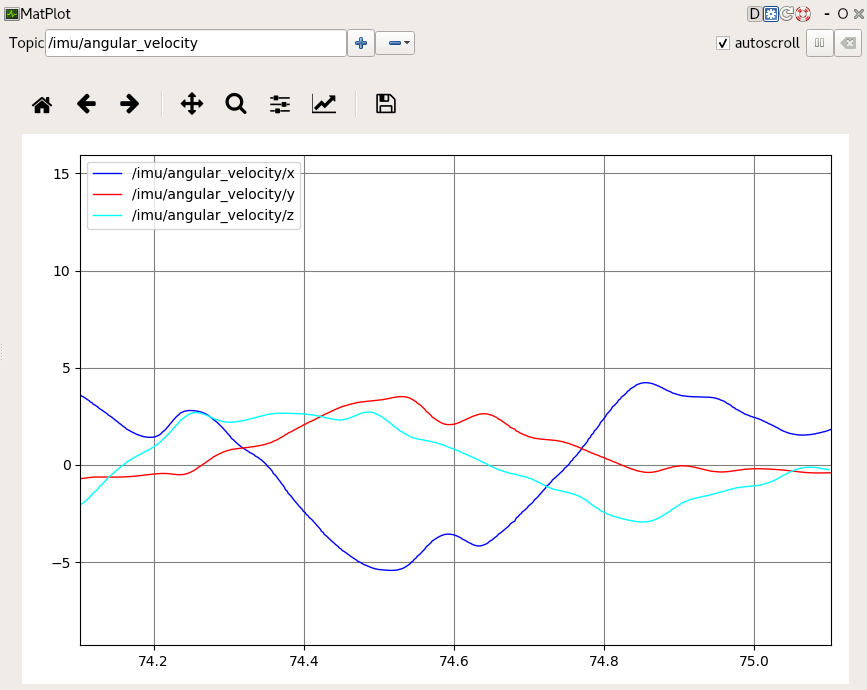Robot Operating System (ROS)¶
Overview¶
The OpenZen ROS driver is hosted in a separate git repository. In provides
the ROS package to readout OpenZen sensors and provide IMU and magnetometer measurements via ROS topics.
For ROS driver supporting LPMS3, NAV3, and IG1 sensors, please checkout branch feature/LPMS3_support.

Installing via the Package Manager¶
The OpenZen ROS driver is part of the official ROS distribution and you can conveniently install it via the package manager of your Linux distribution. Please check this website to see if the OpenZen ROS driver is available for the ROS distribution you use:
https://index.ros.org/p/openzen_sensor/bitbucket-lpresearch-openzenros/#melodic
For example, on Ubuntu 18.04 and with ROS distribution Melodic Morenia, the OpenZen ROS driver can be installed with this command:
apt install ros-melodic-openzen-sensor
Compilation¶
If OpenZen is not available for your ROS distribution or you want to customize some OpenZen options, you can also compile the OpenZen ROS driver yourself.
To compile the driver in your ROS setup, follow these steps:
mkdir -p catkin_ws/src
cd catkin_ws/src
git clone --recurse-submodules https://bitbucket.org/lpresearch/openzenros.git
# get your ROS environment going
source /opt/ros/melodic/setup.bash
cd ..
catkin_make
source ./devel/setup.bash
Running the Driver¶
Before running the driver, please ensure that the access rights to the serial port on your system are properly configured as described in the Linux IO system section.
Open a new terminal window and run the ROS core:
source /opt/ros/melodic/setup.bash
roscore
You can then run the OpenZen ROS driver with this command in the window you used to compile the software:
rosrun openzen_sensor openzen_sensor_node
By default, it will connect to the first available sensor. If you want to connect to a specific sensor, you can use the serial name of the sensor as parameter, for example:
rosrun openzen_sensor openzen_sensor_node _sensor_name:="devicefile:/dev/ttyUSB1"
It is always recommended to pass a baud rate:
rosrun openzen_sensor openzen_sensor_node _sensor_name:="devicefile:/dev/ttyUSB1" _baudrate:=115200
If the sensor is in USBXpress mode, you may connect the sensor as follow:
rosrun openzen_sensor openzen_sensor_node _sensor_interface:="SiUsb" _sensor_name:="lpmscu2000573"
Now you can print the IMU values from ROS with:
rostopic echo /imu/data
Or plot some values (for example linear acceleration) with
rosrun rqt_plot rqt_plot /imu/data/linear_acceleration
If you want to readout the values of two OpenZen sensors simultanously, you need to rename the topics and the node names likes this:
rosrun openzen_sensor openzen_sensor_node __name:="cu2node" _sensor_name:="devicefile:/dev/ttyUSB0" imu:=/cu2_imu
rosrun openzen_sensor openzen_sensor_node __name:="ig1_node" _sensor_name:="devicefile:/dev/ttyUSB1" imu:=/ig1_imu
You can also select another IO interface, for example Bluetooth:
rosrun openzen_sensor openzen_sensor_node _sensor_interface:="Bluetooth" _sensor_name:="00:11:22:33:FF:EE"
Alternatively, you can use the sample launch file (openzen_lpms_ig1.launch) start data acquisition and plotting using openzen_sensor_node:
roslaunch openzen_sensor openzen_lpms_ig1.launch
Limitations of OpenZen ROS driver¶
The default binary distribution and source compile for the OpenZen ROS driver does not support Bluetooth sensor models.
Therefore, if you want to use Bluetooth sensors together with ROS you need to follow the instructions above to compile the
OpenZen ROS driver. Before compiling the driver, you need to set the option ZEN_BLUETOOTH to ON in the CMakeLists.txt file in
the root folder of the OpenZenRos repository.
ROS API¶
The openzen_sensor driver publishes orientation, angular velocity, linear acceleration and magnetometer data (covariances are not yet supported). If your sensor models is equiped with a GNSS receiver unit it also publishes the NavSatFix message.
Published Topics¶
- /imu/data (sensor_msgs/Imu)
- Inertial data from the IMU. Includes calibrated acceleration, calibrated angular rates and orientation. The orientation is always unit quaternion.
- /imu/mag (sensor_msgs/MagneticField)
- Magnetometer reading from the sensor.
- /imu/nav (sensor_msgs/NavSatFix)
- Global position from a satellite navigation system. Only available if the IMU includes a GNSS chip.
- /imu/is_autocalibration_active (std_msgs/Bool)
- Latched topic indicating if the gyro autocalibration feature is active
Services¶
- /imu/calibrate_gyroscope (std_srvs/Empty)
- This service activates the IMU internal gyro bias estimation function. Please make sure the IMU sensor is placed on a stable platform with minimal vibrations before calling the service. Please make sure the sensor is stationary for at least 4 seconds. The service call returns a success response once the calibration procedure is completed.
- /imu/reset_heading (std_srvs/Empty)
- This service will reset the heading (yaw) angle of the sensor to zero.
- /imu/enable_gyro_autocalibration (std_srvs/SetBool)
- Turn on/off autocalibration function in the IMU. The status of autocalibration can be obtained by subscribing to the /imu/is_autocalibration_active topic. A message will published to /imu/is_autocalibration_active for each call to /imu/autocalibrate.
Parameters¶
- ~sensor_name (string, default: null)
By default, the library will connect to the first available sensor. If you want to connect to a specific sensor, you can use the serial name of the sensor as sensor_name parameter as follow:
$ rosrun openzen_sensor openzen_sensor_node _sensor_name:=”devicefile:/dev/ttyUSB1”
- ~sensor_interface (string, default: LinuxDevice)
- Name of IO system for initiating sensor connection. For more details, please check the documentation in the section IO Systems.
- ~baudrate (integer, default: 0)
- Baudrate in bits per seconds used to connect to the sensor. It is recommended to pass the baud rate according to this section IO Systems. If the baud rate is left at 0, OpenZen will automatically pick the default baud rate for the respective sensor model.
- ~frame_id (string, default: imu)
- The frame in which imu readings will be returned.